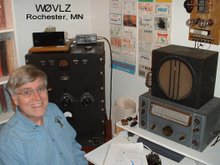I've finished my 1T4 / 3V4 Regenerative Portable. Along the way I found Dave's "Regenerative Tube Radio Building Notes" at
http://makearadio.com/misc-stuff/regennotes.php . Dave condenses down to a few pages a lot of the information that you need to know about regen receiver design/options without spending a lot of time on theory. It fits his philosophy of "No big theory discussions or math here. You are here to build a radio,
not to earn your college degree." This was helpful as I made design changes to fit parts available.
The first parts constraint I (didn't) find was a small bandspread capacitor. What I had was one in the range of 10-35pF and I was looking for something around 3-10 pF. A 10 pF fixed capacitor in series with my 35 pF bandspread capacitor got me the bandspread I needed without modifying my capacitor.
Next, the original design from Bob's Data had both low and high impedance outputs. I'm only using high impedance headphones so I replaced the 10K to 8 ohm output transformer with a 3:1 inter-stage coupling transformer. I had also hoped transformer coupling to my headphones would increase the volume...that didn't happen. More on this later.
I also decided to add an antenna coupling control. I'm not certain this helps a lot but it may come in handy when connected to a long/resonant antenna.
Finally, all of Dave's feedback control options show an RF choke in the B+ line going to the tickler coil. This seemed like a good idea. It keeps the feedback RF all at the coil rather than wandering around the chassis.
Bob's design information included coil winding documentation. I had a set of pre-wound 1930's vintage Hammarlund 6 pin shortwave coils. I used these rather than wind my own coils.


The final radio looks good and nicely covers 80 and 40 meters. I have several sets of high impedance headphones that I've acquired over the years. My Neufeldt & Kuhnke Model D headphones gave the best volume. This is a battery set designed for A/filament voltage from a flashlight
battery and B+ from a series of 9V batteries. I used my 20s battery set
power supply from Antique Electronic Supply. This power supply provides the regulated A and B voltages that I needed. See
https://www.tubesandmore.com/products/K-101A .
I'm a little disappointed in performance but this is a 1940s/1950s starter set. Maybe this is a good as it gets. Volume is low and the regeneration setting is tricky. When regeneration is set for maximum sensitivity I feel like I'm riding the crest of a wave. Any move may send the set out of CW regeneration or hurt sensitivity. What I'm seeing may be because of the tickler winding. Most references I've found indicate that the correct regen pot setting is at about 12:00. Mine is closer to 9:00...the screen voltage (and, consequently, the 1T4 gain) is pretty low when CW regeneration kicks it. Is this a problem? I don't know. The plate voltage is still the same. I'll have to wind a coil and play with the tickler winding to find out. The other limitation I found was antenna loading impact on the received frequency. Changing my antenna trimmer setting changed the frequency a lot. The solution was to add an RF stage. This won't happen. Once the C1, the bandset capacitor, is set I leave the antenna trimmer alone.






